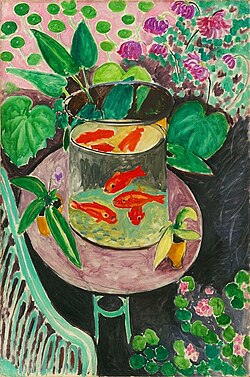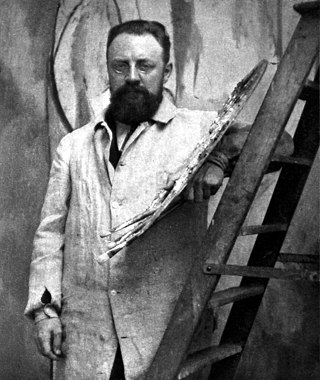
Henri Émile Benoît Matisse was a French visual artist, known for both his use of colour and his fluid and original draughtsmanship. He was a draughtsman, printmaker, and sculptor, but is known primarily as a painter. Matisse is commonly regarded, along with Pablo Picasso, as one of the artists who best helped to define the revolutionary developments in the visual arts throughout the opening decades of the twentieth century, responsible for significant developments in painting and sculpture.

Paul Victor Jules Signac was a French Neo-Impressionist painter who, with Georges Seurat, helped develop the artistic technique Pointillism.
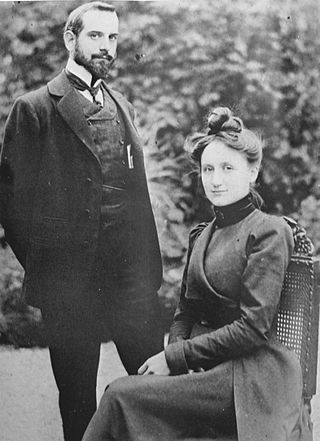
Henri Charles Manguin was a French painter, associated with the Fauves.

Dance (La Danse) is a painting made by Henri Matisse in 1910, at the request of Russian businessman and art collector Sergei Shchukin, who bequeathed the large decorative panel to the Hermitage Museum, in Saint Petersburg. The composition of dancing figures is commonly recognized as "a key point of (Matisse's) career and in the development of modern painting". A preliminary version of the work, sketched by Matisse in 1909 as a study for the work, resides at MoMA in New York, where it has been labeled Dance (I).

Woman with a Hat is a painting by Henri Matisse. An oil on canvas, it depicts Matisse's wife, Amelie. It was painted in 1905 and exhibited at the Salon d'Automne during the autumn of the same year, along with works by André Derain, Maurice de Vlaminck and several other artists known as "Fauves".

The Conversation, a painting by Henri Matisse dating from 1908 to 1912, depicts the artist and his wife facing each other before a background of intense blue. It is in the collection of the Hermitage Museum in Saint Petersburg, Russia.

Zorah on the Terrace is an oil on canvas painting by French painter Henri Matisse, created in 1912. It is in the collection of the Pushkin Museum of Fine Arts, Moscow, Russia.

Odalisque With Raised Arms is a painting by Henri Matisse, completed in 1923. The oil on canvas measuring 23 by 26 inches is held in the National Gallery of Art, in Washington D.C.. Matisse's style changed and evolved drastically throughout his career, including his wide and varying collection of paintings depicting female nudes. His odalisque paintings were inspired by his trip to Morocco. Many of the female subjects in the Odalisque paintings were modeled after Matisse's main model at the time, Henriette Darricarrère.

The Red Studio is an oil on canvas painting by French artist Henri Matisse from 1911. It is held in the collection of the Museum of Modern Art, in New York.
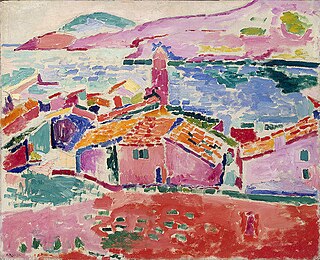
View of Collioure is a 1905 oil-on-canvas painting by Henri Matisse. It is an example of the style that Matisse employed during his early period of Fauvism. The painting has been in the collection of The Hermitage, St. Petersburg, Russia since 1948. It was originally part of the Sergei Shchukin collection, and then was at the State Museum of New Western Art in Moscow.

Window at Tangier; also referred to as La Fenêtre à Tanger, Paysage vu d'une fenêtre, and Landscape viewed from a window, Tangiers, is a painting by Henri Matisse, executed in 1912. It is held at the Pushkin Museum of Fine Arts, Moscow.
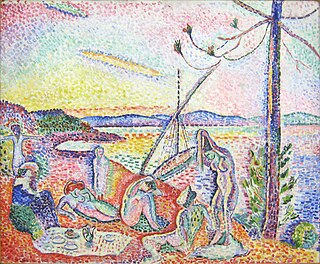
Luxe, Calme et Volupté is a 1904 oil painting by the French artist Henri Matisse. Both foundational in the oeuvre of Matisse and a pivotal work in the history of art, Luxe, Calme et Volupté is considered the starting point of Fauvism. This painting is a dynamic and vibrant work created early on in his career as a painter. It displays an evolution of the Neo-Impressionist style mixed with a new conceptual meaning based in fantasy and leisure that had not been seen in works before.

Fauvism is a style of painting and an art movement that emerged in France at the beginning of the 20th century. It was the style of les Fauves, a group of modern artists whose works emphasized painterly qualities and strong colour over the representational or realistic values retained by Impressionism. While Fauvism as a style began around 1904 and continued beyond 1910, the movement as such lasted only a few years, 1905–1908, and had three exhibitions. The leaders of the movement were André Derain and Henri Matisse.

Sergei Ivanovich Shchukin was a Russian businessman who became an art collector, mainly of French Impressionist and Post-Impressionist art.

De strijkster is a painting by Rik Wouters in the Royal Museum of Fine Arts Antwerp. It is one of many scenes from daily life from which the painter found inspiration and took as a subject. His wife, muse and favourite model was Hélène Duerinckx (Nel).
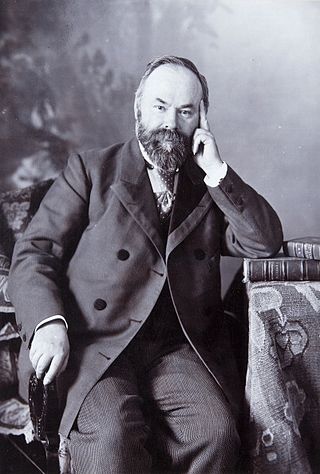
Pyotr Ivanovich Shchukin was an art collector who built an important collection of Russian ancient art and artifacts and owned several impressionist masterpieces.

Female Nude is an 1876 painting by Pierre-Auguste Renoir, also known as Nude Woman Sitting on a Couch, Anna, After Bathing and Pearl. It is housed in the Pushkin Museum, in Moscow, and is an example of Renoir's many nude paintings, a recurring subject that preoccupied him throughout his life. The painting was created in the characteristic soft brush strokes of the Impressionist movement to emphasise feminine beauty.
Bathers by a River, also known as Bathers at the River and occasionally referred to as simply Bathers, is a large 1917 oil-on-canvas painting by French artist Henri Matisse. Matisse began painting the canvas in 1909 and finished the painting in the fall of 1917, making it one of three pictures he painted during the Battle of Verdun.

French visual artist Henri Matisse was known for his use of color and draughtsmanship. In the early 20th century, Matisse became a leader of the Fauvism art movement, which was an early movement in the broader Post-impressionist era.
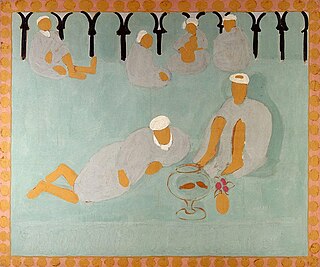
Arab Coffeehouse, is an oil-on-canvas painting by French visual artist Henri Matisse. Produced in 1913, Arab Coffeehouse was part of a series of goldfish paintings that Matisse produced in the 1910s and 1920s.
